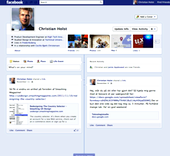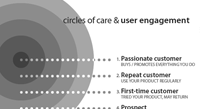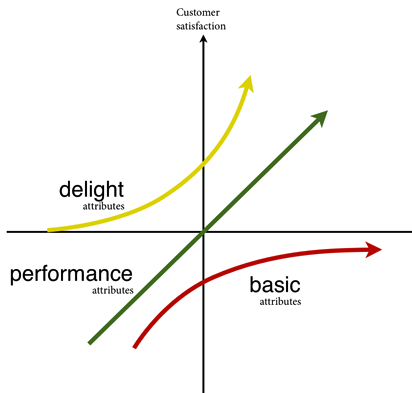Facebook features are designed to trigger social behavior, not create it. Neither software nor media is social, rather it’s human beings that are social. Facebook and Twitter aren’t social software systems, they are systems that afford certain social behavior.
This is an important distinction to make when deciding which “social media” tools to use and how to use them. Instead of analyzing the features of platforms such as Facebook and Twitter we must analyze their social affordances – the types of social behavior they are designed to trigger and how that fits in with our business.
Analyzing Social Affordances
In analyzing the social affordances of a platform like Facebook or LinkedIn, it’s beneficial to look at the history, social structures and culture of each and see how you may use these platforms in such a way that their unique characteristics align with the goals of your organization. Furthermore, you must consider the role of your presence on the platform in relation to its members and groups, and how they will be able to benefit from your presence.
Structure and Agency
Borrowing from the social sciences, we can begin by considering structure and agency when analyzing social affordances. The platform sets the boundaries for engagement between individuals and its social practices clearly influence people’s interpretation of the platform. Yet at the same time it’s ultimately people themselves that put the wheels into motion – it is the individual who engages via the platform, appropriating the system to his own needs and interests. It’s the actions of (millions of) individuals that create connections and content on these platforms, with the structure of those platforms organizing these relationships and the (social) practices setting the context and thus shaping this behavior.
What’s particularly important here is understanding the history and culture of the platform and how that shapes people’s behavior on it, while appreciating that it is ultimately individuals that must initiate any engagements. If your business is to successfully utilize a platform like Twitter you must understand the history of the platform, its social structures and the type of people using it. You must then identify areas of your business or product(s) that align with the platform’s culture and use that to guide your contributions on the platform.
More specifically, you must understand what kind of connections and engagements people make on this platform – and determine which of those are afforded by design and which are the result of members’ creative appropriations of the platform. Pay particular attention to both the linguistic and visual language. Do people “Follow” someone or “Like” something? Twitter is humanized in language (you follow a living entity) whereas Facebook is less direct but also less restrictive in its language (you “like” not only people but also inanimate objects), while one “dig(g)s” an article on Digg.com, which may once have sounded pretty cool to any hipster who thought he was a beatnik and totally identified with Dean Moriarty.
In short: your efforts must be sensitive to the unique social structures and culture of the platform and you must identify areas of your business that align with those elements.
The Self and the Group
The formation of social groups, both offline and online, is incredibly complex with an endless push-pull dynamic between the members of the group working to establish themselves as unique individuals while at the same time trying to fit into the group. There is a constant co-creation of the self and an ongoing evaluation of its relation to and place within the group. The group thus shapes its members and their actions, while the group simultaneously only exists as a consequence of this set of ultimately unique individuals who are continually reframing and adjusting their identities and, as a byproduct, are continually (re)negotiating the group’s purpose and practices.
What’s important is understanding what it is the group represents to its members and what the norms and practices are within that community, while at the same time studying what the individual members are trying to achieve by being part of this group. How are they using the group to build their identity to the outside world while also continually arbitrating their purpose and position and identity within the group itself. Are you able to help people build their identity? Are you able to connect them with other people in meaningful ways? Are you able to challenge them without insult?
Once you understand the motivations of the group’s members and the collective purpose and practices of the group, you’re better able to understand how your business can best fit into that picture. If you position yourself in such a way that people have a vested self-interest in engaging with you, then your efforts on the platform will be much more successful because people are naturally inclined to engage with you as it helps them construct their desired identity (either in relation to you or in relation to their peers or other groups, or all of them at once).
In short: your presence must either enable the group or the individual to achieve its goals, or become the group itself.
Case: Facebook vs LinkedIn
An obvious comparison is that of Facebook vs LinkedIn. Technically speaking, both of the platforms allow you to create a profile and connect and interact with other people and groups, and those that are in your network get access to more information in your profile. So when looking at the core functionalities of the two platforms they may not seem all that different, yet, they are clearly framed and used very differently.
Drawing on the “Structure and Agency” section, we see how the culture and language of the two platforms are vastly different. On Facebook, you connect with “Friends” whereas on LinkedIn you create “Connections” with “Contacts”. There are vastly different norms for the type of content that you share and the type of people you connect with. Much of this is by design, of course. On Facebook you’re encouraged to find and reconnect with old classmates. On LinkedIn you’re encouraged to expand on your CV and give recommendations of people. These differences in culture and history also has implications for when people are using a platform. For example, it is generally more acceptable to use LinkedIn during work time than Facebook (with obvious exceptions made if your job actually requires you to work on one of these platforms), in large part because of how the two platforms have been framed and shaped over time.
Drawing on the “The Self and the Group” section, we see that people want to build a vastly different identity on these platforms and have very different reasons for using each platform and connecting with groups. On Facebook your profile is personal, while on LinkedIn it’s professional. Therefore people want to build and nurture a professional identity on LinkedIn and will join groups that can further their career and participate in forums to expand their professional network and present their best face to potential employers. On Facebook, people are looking to portray a very different identity, and may “Like” a page simply because it’s fun or share an academic article about The Wire because they want to look hip (or whatever image it is they want to portray of themselves).
Clearly Facebook and LinkedIn are used in very different ways and for very different purposes. Identifying these social affordances will allow you to better understand how to use each platform and how to make the most out of your presence on them.
Tailor Your Presence Accordingly
Each platform must be used in a unique way that’s sensitive to its social structures and the culture of the platform while also accounting for the unique aspects of your business. You must understand how individuals and groups will benefit from a relationship with you on this platform, and consider the relational role of your presence. Are you the group or do you play a supportive role in a larger system? Why should individuals engage with you, will it make them look smart or funny (or whatever it might be that also happens to align with your business)?
Once you have laid out the social affordances of each platform and how they relate to your business, you will have a much better idea of how to successfully use the platform. With a clear picture of the platform’s culture and connections, you can strategically tailor your contributions to the unique aspects of each platform and align the goals of its members with those of your business.





